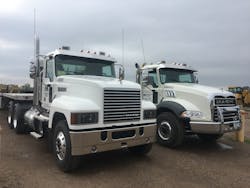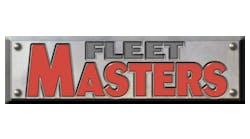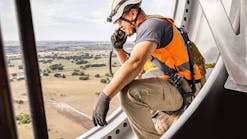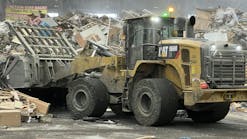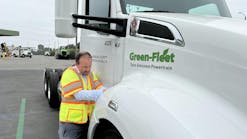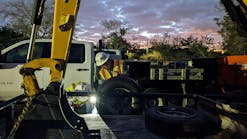“Without clear direction on what it is we want mechanics to do and oversight on what it is they’re actually doing, you end up with a lot of strange combinations occurring in the field,” says Vic Krauze, director of fleet & equipment for Minnesota Limited, Big Lake, Minn.
Minnesota Limited is a pipeline and station contractor primarily working on lines that carry crude oil and natural gas, as well as on compressors, modifications, and repairs.
Minnesota Limited, Big Lake, Minn., is the large-fleet winner of the 2018 Fleet Masters Award. Small-fleet winner Ryan Inc. Central was profiled in the July issue. The awards are presented by Construction Equipment and the Association of Equipment Management Professionals (AEMP), and are judged on categories such as finance, information management, policies, and controls.
“Until three or four years ago, our maintenance activities were very decentralized,” Krauze says. “A lot of times what mechanics were actually doing on the job sites was quite different than what we would do in the facility.
“That’s everything from using different lubricants to changing [service] intervals—a lot of times they weren’t hitting service intervals when they should be, so if the intervals were 500 hours, they might get stretched out to 600 or 700 hours,” Krauze says.
It all added up to a lack of uniformity, with many mechanics essentially doing their own thing. This was further complicated by the fact Minnesota Limited is a union contractor and often works with a mix of its own employees and union help that may or may not be familiar with the company.
“On any given project, we take 50 percent of our labor force for that project from the Local hall,” Krauze says. “So we have a lot of folks we carry with us who have a lot of experience with other contractors that have their own methodologies that they want to utilize based on that experience, then we have 50 percent of the folks on that job that have never worked for us before.”
On top of inconsistent maintenance practices, Minnesota Limited experienced a growth spurt that started in 2012. “And with that, we added mountains of equipment to our fleet,” Krauze says. “With all that new equipment coming into the fleet you’d expect your repair costs, if nothing else, to go down as compared to utilization.
“And that did occur for the first couple of years. Then as we started seeing things come out of warranty and the fleet get a little bit of age to it, those costs started going up,” Krauze says. “And they started going up a bit outside of what we would have even expected back in 2011 or 12.”
Specifically, it was the cost per utilization hour that drew the most attention. It was time for a change—and uniformity.
“Part of that [cost increase], in my opinion, is due to all of this Tier 4 equipment, because it’s more costly to maintain that than your Tier 3 and previous machines,” Krauze says. “The other portion is that, frankly, our guys weren’t equipped properly to do a lot of what needed to be done to maintain this equipment on their own. They didn’t have the tooling.”
It also became a matter of providing information to the field on exactly what maintenance needs to be done, by machine category. No longer would mechanics operate solely on their prior experiences.
Runner up Rogers Group tackles Tier 4 head on with proactive technician training
“We don’t just need to change the oil on an excavator at 2,000 hours; we’re saying ‘Here’s a list of 40 different tasks that need to be done,’” Krauze says.
Step one for Minnesota Limited in its quest to secure uniform maintenance guidelines was to interface with its vendors.
“We wanted to understand what it was that we needed to be doing so that we’re not running this equipment thinking we’re keeping up on the maintenance and then experiencing failures and other costly issues that would have to be repaired down the line,” Krauze says.
“It wasn’t necessarily that we were spending too much on maintenance, it’s that we weren’t spending enough on maintenance,” Krauze says. “And other issues later on down the line, 1,000 or 1,500 hours later, were catching up to us.”
With help from its dealers, the company produced written guidelines for its mechanics for major machine categories in the fleet.
“Our average fleet size is right around 1,200 pieces of heavy equipment; it fluctuates, and we’ll size it as necessary through leases and rentals,” Krauze said.
Excavators are the largest segment of the fleet, at 450, with sizes ranging from 80,000 pounds down to 20,000 pounds, but Krauze also oversees dozers, loaders, compact equipment, and 700 on-road vehicles, half commercial and half pickups.
Then it was time to seek buy-in from the field.
“You have to get buy-in, so rather than sitting down and coming up with what it is we want done and sending it out saying, ‘You will now do this,’ we put plans together for categories of machines; for excavators, for example, we put together a book that showed what we wanted done at every PM,” Krauze explains.
“It’s a lot of communication. It’s giving them that documentation that shows exactly what needs to be done,” Krauze says. “And explaining it to them so that they understand it, and following up with them continuously to make sure it’s done.”
As with all change, there was some resistance. “We still [see some resistance],” Krauze says. “Our biggest issue is that we have a lot of individuals who are just used to operating on their own. When given guidance as far as what should be done to maintain the fleet, they’re just resistant to that oversight.”
Call it sensitivity to a new Big Brother.
“So you get a lot of ‘I’ve been doing this for over 20 years and it’s always worked, why should I have to tell you what I’m doing?’” Krauze says.
“The other aspect of it is when you’re requesting that all of this be done and there’s documentation for it so that we can track it, that adds another step that these guys weren’t used to,” he says. “They’re used to going out, changing the oil on stuff, slapping a sticker on the filter, calling it good, and moving on with life.
“It really gets down to explaining to them the value of what it is we’re doing,” Krauze says. “Helping them see that if we do make this effort, our uptime goes up, our utilization goes up, their jobs become easier because they’re focused on things that they’ve planned rather than having to spend all day chasing problems that have just appeared.”
In addition to the communication, Krauze sought feedback on the maintenance guidelines.
“We sent it out to our master mechanics who typically stay with us, and the feedback was very good,” Krauze says. “We have some very talented individuals that came up with things like ‘I know the manufacturer says we should be doing this at this interval, but here is what we experience out here.’ Air filters were a big one; a lot of manufacturers don’t recommend changing air filters but every few thousand hours. We have a lot of guys, depending on the conditions they’re working in, replacing them every PM.
“What they [manufacturers] do recommend doing is blowing them out with an air compressor, and that’s not always the best situation to have, because you risk damage to that filter, and, are you really getting all that particulate out of there?” Krauze says.
Krauze knew the guidelines were catching on when he began to field certain questions from his mechanics.
“We started getting the feedback, ‘What about guidelines for directional drill rigs, what about some for telescopic cranes?’ When they ask about all these other areas, that’s when you know they’re really buying in,” he says.
Equipment operators had to buy-in, too, particularly on inspections.
“You can do all of this work with mechanics, but your operators are really the first link in your chain, and they can notice issues that may be arising,” Krauze says.
“We have some that are very good [with walk-arounds]. We have a lot that have room for improvement,” Krauze says. “We preach to our supervisors and we preach to our operators when we have a chance, if they’re just pencil-whipping their daily inspection, there’s no point in even doing it. They’re wasting their time and they’re wasting ours, because we have to look through them. And we can tell, if a guy just draws a line down through every check box on his inspection, that he’s probably not doing it.”
Another issue Krauze points out is that operators don’t want to be held accountable for something they feel isn’t their fault.
“You end up with a lot of guys who won’t bring up issues they’re seeing; they don’t want to be blamed for something that may not have happened on their watch,” he says. “Also, they don’t want to be blamed for the downtime, as in okay, now that this happened, we have to take the machine down for a half a day to fix it.
“The only way to overcome that is to get in front of these guys and make them understand that [blame] is not what’s going to happen,” Krauze says. “We do go out and do some of that, but it’s a lot more valuable when the supervisor tells them, so we do a lot of preaching to our supervisors. The operator’s going to see that supervisor every day, so he’s accountable to him.”
Most of Minnesota Limited’s maintenance guidelines are disseminated manually, emailed in a PDF format, but the company is constantly looking at improving its offerings.
“We have a mobile app for our organization that any employee can download on their cell phone, and there are a lot of offerings through manufacturers for mobile interfacing, and that’s something we’re delving into now,” Krauze says.
Once the guidelines took hold, by 2016, every machine in the fleet had to be evaluated. It was a huge undertaking.
“After we really understood what needed to be done at every different interval, it was a matter of getting everything caught up to where it needed to be at that point in time,” Krauze says. “So all through 2016, we made sure every machine was inspected and all those tasks we hadn’t caught up on were complete.”
After Minnesota Limited’s major maintenance changes and a year or so of “catch up” on its equipment, there was a positive change to the cost per utilization hour that is still evolving.
“We started seeing savings last year per utilization hour, and we’re still seeing that today,” Krauze says. “We based our budget for 2018 on what we had seen in 2017 and we’re beating that by 25 percent today.”
The savings have had a ripple effect company wide. Krauze thinks there have also been gains because of word of mouth.
“In maintaining the fleet at a higher level, our customers see that, and they’re more apt to believe we can be more successful approaching a contract versus a contractor that does have issues with downtime,” Krauze says.
“The other side of it is an environmental aspect; if you have equipment that’s breaking down, hoses are breaking, leaks are occurring, that’s something that our customers are very averse to having on their projects,” he says.
“When you look at it, all the equipment division can do is operate efficiently to make the rest of the business more profitable,” Krauze says. “If we’re more efficient at keeping our costs down, that allows us to be more effective at bidding work. And we become busier. That’s our pressure from Operations, to get our costs down. The market is very competitive today. There’s a lot of work out there, but there are a lot of players in it as well.
“We need to be as efficient as possible to give them the best chance to succeed, because more effective bidding means more profit for company,” Krauze says
Minnesota Limited typically operates from the edge of the Dakotas through Pennsylvania and Ohio, and as far south as Kentucky and Tennessee, but has expanded its reach with newer jobs in Oklahoma, Kansas, and Missouri.
It may well have its maintenance program overhaul to thank.
